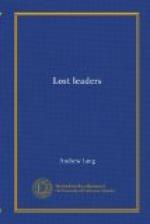First, the angler notices a rising fish. Then he retires to a safe distance from the bank, outflanks the trout, and comes round in his rear. As fish always feed with their heads up stream, it is necessary in such clear water to fish for them from below, from as far below as possible. Every advantage is taken of cover, and the angler soon acquires the habits of a skirmisher. A tuft of rushes, an inequality in the ground, or an alder bush conceals him; behind this he kneels, and gets his tackle in order. He uses only one fly, not two or three, as people do on the Border. He carefully measures his ground, flicking his cast through the air, so that the fly shall be perfectly dry. Then the trout rises, and in a moment the dry fly descends as lightly as a living insect, half a foot above the ripple. Down it floats, the fisher watching with a beating heart: then there is a ripple, then a splash; the rod bends nearly double, the line flies out to the further bank, and the struggle begins. The fight is by no means over, for the fish instinctively makes for a bed of weeds, where he can entangle and break the line, while the angler holds him as hard as he dares, and, if tackle be sound and luck goes not contrary, the big trout is landed at last.
This is no trifling victory. Nay, a Kennet trout is far harder to catch and kill than the capricious salmon, which will often take a fly, however clumsy be the man who casts it. There is a profane theory that several members of the Hungerford Club never catch the trout they pay so much to have the privilege of trying to capture. A very sure eye and clever hand are needed to make the fly light dry and neat




